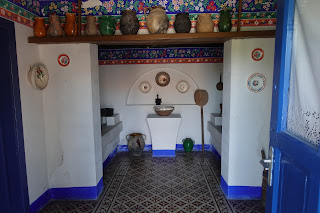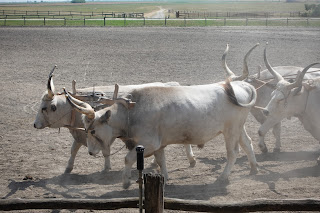Kalocsa, the Paprika Capital
After dinner, it was time to set sail. `the city water front is brightly lit and we were treated to a display. We had moored facing upriver so that the captain had the most control of the ship against the current for maximum manuvreability. We sailed up river to use Magrit Island as a roundabout to turn and set off down stream.
The Royal Palace.The Parliament building.
The Magrit Bridge.
A party boat with loud music pumping out across the water.Another boat moored on the water front.
And a modern building with coloured lights that changed as we sailed past...
...red...
We sailed overnight ad reached Kalocsa on the Great Hungarian Plains. This is a huge flat area and after the hills and gorges, there wasn't a hill to be seen. The elevation difference across the whole plain is just eight betres from it highest to its lowest point.
Kalocsa was founded by King Stephen in 1040 together with the bishopric in the city although the cathedral only dates from the 18th century. The plain may be flat but it is fertile land with plenty of water and sun. It is known as the paprika growing capital of th country and Hungary is the world' largest producer of paprika and cooks use it in just about every dish.
Our first stop of the day was a Folklore Museum. It was donated to the city by a local man in 1951 and preserves the way of life carried on for centuries. It has a row of farm buildings converted to a theatre, souvenir shop and modern toilets.
The former farmhouse and living area was built on a small man made mound. Before the Danube was tamed by engineers, this area was fertile but swampy in places and subject to flooding.
Paprika hanging up to dry under the eaves of the house.
The farmhouse has just four rooms and through the front door, the first room is the kitchen.
The other side the kitchen was a living room where the family would sleep in winter. This farmhouse was also unusual as it had a further room beyond...
...which housed many of the artefacts that the wife would create.
Underneath the house was a storage area.
It was a short drive to the House of Paprika, a museum about paprika. The whole of the bottom wall of the house was covered with paprika drying in the sun.
It also has some agricultural displays and several different types of paprika growing in the garden, sweet, strong and hot versions, each with their own names and characteristics.
A hand plough.
Some of the many products made from paprika.
Another plough.
We were treated to wine, a slice of bread with lard and paprika topping plus a glass of apricot brandy or locally made palinka.
The horsemen were waiting and dressed in traditional costumes, baggy pantaloons baggy sleeves to their shirts, waistcoat and hat.
We were introduced to the local breed of cattle. They have large horns and slow but are very strong, useful to pull heavy wagons through the mud. Their meat makes excellent dishes but their milk is inedible for humans.
...getting the horse to lie down...
...using the horse to see over long grass without getting on...
...notice the saddle which is thin with no girth strap, it merely rests on the horses back but its thinness means that the rider can feel all of the horses movements...
... the dog position, a horse sitting like a dog and if you ride bareback, you can use the hind quarters as a mounting block and as the horse stands up, the rider slides onto the horses back.
A greeting to the crowd and then some games, like the Hunting Game, using the whip to knock over a small log standing on the ground which was a useful skill for hunting small game or rabbits...or here, the Balancing Game, riding around the area wth a glass of wine and not spilling any...
...or the Love Game...
...where one rider has the shawl of a lady and the other riders have to try and grab it off him and return it to the lady for her favour.
And a last run past the stand by the carriage...
Our first stop of the day was a Folklore Museum. It was donated to the city by a local man in 1951 and preserves the way of life carried on for centuries. It has a row of farm buildings converted to a theatre, souvenir shop and modern toilets.
The former farmhouse and living area was built on a small man made mound. Before the Danube was tamed by engineers, this area was fertile but swampy in places and subject to flooding.
Paprika hanging up to dry under the eaves of the house.
The farmhouse has just four rooms and through the front door, the first room is the kitchen.
To the left is the Guest Room or Clean Room with a window looking out into the street. It was keep clean and tidy and not used by the family except to house guests. Glass was expensive and there was a window tax so there were few other windows in the house.
In one corner was an oven to keep the room warm with the hole to fuel the fire in the kitchen and smoke escaped through a hole in the roof of the kitchen, not a chimney.The other side the kitchen was a living room where the family would sleep in winter. This farmhouse was also unusual as it had a further room beyond...
...which housed many of the artefacts that the wife would create.
Underneath the house was a storage area.
It was a short drive to the House of Paprika, a museum about paprika. The whole of the bottom wall of the house was covered with paprika drying in the sun.
It also has some agricultural displays and several different types of paprika growing in the garden, sweet, strong and hot versions, each with their own names and characteristics.
A hand plough.
Some of the many products made from paprika.
Another plough.
Some of the furniture inside the house and a little more upmarket than seen in the farmhouse.
And then it was a drive to a horse farm to see a demonstration of Hungarian riding skills.
The main reception area and souvenir stall.We were treated to wine, a slice of bread with lard and paprika topping plus a glass of apricot brandy or locally made palinka.
The horsemen were waiting and dressed in traditional costumes, baggy pantaloons baggy sleeves to their shirts, waistcoat and hat.
We were introduced to the local breed of cattle. They have large horns and slow but are very strong, useful to pull heavy wagons through the mud. Their meat makes excellent dishes but their milk is inedible for humans.
A closer detail.
Then it was a demonstration of riding skills and of course cracking the whip...and in tune with each other...
Other skills demonstrated included ......getting the horse to lie down...
...using the horse to see over long grass without getting on...
...notice the saddle which is thin with no girth strap, it merely rests on the horses back but its thinness means that the rider can feel all of the horses movements...
... the dog position, a horse sitting like a dog and if you ride bareback, you can use the hind quarters as a mounting block and as the horse stands up, the rider slides onto the horses back.
A greeting to the crowd and then some games, like the Hunting Game, using the whip to knock over a small log standing on the ground which was a useful skill for hunting small game or rabbits...or here, the Balancing Game, riding around the area wth a glass of wine and not spilling any...
...or the Love Game...
...where one rider has the shawl of a lady and the other riders have to try and grab it off him and return it to the lady for her favour.
A carriage with three horses arranged side by side.
And a great feat......standing on two horses whilst controlling ten horses...the record is controlling twenty horses.
And a last run past the stand by the carriage...
...and the man standing on the horses.
That evening we set sail but had to stop at Mohacs. It is where the invading Ottoman's defeated a Hungarian army in 1526. Their empire stretched along the shore of North Africa to Algeria, south to Aden and east to the Persian Gulf. They advanced north and captured Belgrade.
King Stephen had to raise an army to protect his kingdom but the kingdom was weak and many of the nobles quarrelled with each other and didn't send troops to support Stephen who had to rely on German mercenaries who made up the bulk of his 25,000 army.
They had some initial success but as the mercenaries were robbing the dead Turks of their wealth, the remaining Turks counter attacked and killed most of the 25,000 army. King Stephen's horse stumbled in the middle of a stream and fell on top of him, killing him. The nobles still couldn't organise a defence and Budapest fell to the Turks who forgot to leave and stayed for 150 years.
That evening in Mohacs was where the Croatian border control boarded the ship to check our passports. It was just one person but it was super efficient and it had to be as it was during dinner and nobody wanted their dinner to get cold.
The passengers were called forward by deck number and the receptionist had all our passports in cabin number order. I gave my cabin number, the receptionist handed my passport to the official who looked at the picture, looked at me, stamped it and she was on to the next person.













































No comments:
Post a Comment